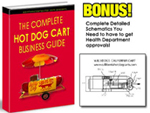How to Prepare for a Hot Dog Cart Health Inspection
How to Prepare for a Hot Dog Cart Health Inspection
Expect surprise inspections
Health department officials will drop by without warning. Treat every operational day like the health inspector is going to pop by. Keeps things clean. Hold you and your staff to the highest hygienic standards.
Make a Scheduled Appointment
Before purchasing any food vending cart, be sure you check with the local health authority first. Foodservice regulations and licensing requirements differ from state to state, county to county, and nation to country. The standards of your local health department must be met before you can obtain your license, pass a health inspection, and begin operations at your new company location.
When you call the health department for the first time, be prepared to ask and answer questions regarding your mobile food cart business. You should bring images or a design of the cart you intend to purchase with you if you have already picked it. This will provide the health inspector the opportunity to ask questions regarding the arrangement and equipment on your cart during the inspection.
Obtaining Specific Information
Ask questions regarding the site, commissaries, and cart equipment requirements at this meeting with the health inspector. You’ll most likely have some questions for the health inspector as well, so prepare them beforehand. Make sure you have a pen and paper with you. Among the items you should cover with the health inspector during this discussion are the following:
Public Health Codes: A written copy of the public health codes in your region should be provided to you by the health inspector. You’ll need this information in order to pass a health examination.
Obtaining a Commissary: A commissary is a kitchen that has been licenced and inspected where you may store supplies and disinfect equipment. In order to pass a health inspection, you must give a commissary location. There should be a number of commissaries in your neighborhood. Inquire with the health inspector about the location of the commissary.
Required Equipment and Building Features: Knowing what equipment and features are required on your cart before you purchase it makes passing the mobile food cart health inspection process much easier. Adding or modifying equipment after it has been constructed might be extremely expensive or perhaps impossible. (Top Dog Carts are made to order and are not available for purchase.) This implies that when your cart is constructed, it will meet all of the structural criteria necessary to function in your location.)
In order to pass the health inspection, you must submit the address of your place of business where you operate. Inquire with the health inspector to see if there are any limits on where you may operate. Some jurisdictions, for example, do not permit vendors to be located near specified structures. If you know which locations are off-limits, it will be much easier to locate a site.
Don’t make educated guesses.
If the health inspector asks you a question concerning the construction of your cart and you aren’t sure how to respond, you should consult with the cart manufacturer. They will be able to offer you with the proper responses.
Obtain information from your inspector regarding the health rules that apply to additional equipment such as grills, griddles, or deep fryers if you intend on acquiring such products.
THE TOP 5 THINGS A HEALTH INSPECTOR LOOKS FOR ON YOUR CART –
When the health inspector comes to check your hot dog cart, he or she will be looking for the following top five items. Frequently keeping an eye on the other two from a distance and then approaching to check on them. Are you making any of these errors?
Of course, the inspector will look at a variety of other items as well – but none will be as critical as the following five. Once you’ve learned what to expect, you’ll never have to worry about a “surprise” inspection in the same way again.
I receive phone calls from vendors who are anxious before an inspection (even though they are aware of the precise day and time of the inspection). My recommendation is as follows:
Remember that the inspectors are actual people, not gods or demons, and that, while some of their egos are directly tied to the “power” they hold, the vast majority are above and above it.
Inspectors are actual humans (just like us) who put their pants on one leg at a time, starting at the bottom. With the exception of inspector Bob, who is superhuman and can perform both tasks at the same time.
Their purpose is not to let you down; rather, it is to ensure that you are supplying food to the public in a safe manner.
Inspectors aren’t going to shut you down because of a clerical error. And, in most cases, even if you are caught in violation of a significant rule, they will correct you on the spot and continue serving you.
If you wanted to get closed down, you’d have to physically have dead people strewn about your cart. But, to be honest, you’d have to be selling terrible food or be very unsanitary in order to be forced to close your doors immediately. That being the case, you shouldn’t be in this line of work at all, anyway.
What really is at risk in the end?
According to the Centers for Disease Control and Prevention, approximately one in every six Americans (or 48 million people) becomes sick each year, 128,000 are hospitalised, and 3,000 die as a result of foodborne infections.
That’s incredible! Someone being killed as a result of a careless ass blunder. I’d be unable to sleep for the rest of my life. It would be a source of anxiety for me. It is for this reason that it is critical that you follow proper food handling procedures.
More information is available for free from the USDA. Another option is to consider taking and passing a food safety certification exam even if your state does not require it.
Health and Safety Concerns Concerning the Hot Dog Cart
Maintaining a proper emphasis on concerns pertaining to health and safety is critical if you are running a hot dog cart business. This involves the health and safety of yourself, any staff, as well as your important clients and consumers.
Even before your business opens its doors for the first time, you should contact your local health department to ensure that you are aware of all of the regulations governing health and safety. Right now, we’ll go over some general considerations to bear in mind when it comes to the health and safety of hot dog carts.
Handling Food in a Safe Manner
We’ll start with a discussion of safe food handling procedures. By failing to follow basic food handling protocols, you are putting the health of your customers at risk, as well as negatively impacting your financial line. Here are a few key concepts to keep in mind when it comes to food handling safety.
Cold food should be purchased last and placed in your refrigerated storage room as soon as possible.
Choose a commissary that is close to where you buy your frozen or chilled food goods if you want to save time and money on transportation costs. In a heated automobile, you should never leave food alone!
Do not purchase food that is in bad shape.
All canned products should be free of any dents, cracks, or bulging lids before being placed on the shelf. These can be signs of a potentially deadly food poisoning outbreak. You should avoid purchasing any food that will not be consumed before its expiration date.
Check to see that the food is adequately chilled.
An appliance thermometer should be used to monitor the temperature of your refrigerator on a regular basis. The refrigerator should be set at 4 degrees Celsius (40 degrees Fahrenheit) in order to prevent bacteria from proliferating.
The temperature of the freezer unit should be -18°C (0°F).
Maintain the cleanliness of the food preparation area.
Before you begin cooking meals, wash your hands well with soap and warm water. Hand washing properly is the most effective method of preventing the transmission of germs. Hands should be washed for at least 15 seconds. Pay close attention to the tips of the fingers, the spaces between the fingers, the backs of the hands, and the base of the thumbs.
Make certain that you thoroughly dry your hands with a single-use disposable towel before continuing.
You should also wash your hands after going to the restroom, coughing, sneezing, blowing your nose, handling money, or touching rubbish, among other things. Please do not touch your clothes or apron after you have washed your hands. This would be counterproductive to the goal of hand washing.
When working with food, it is important to wear protective headwear such as a helmet or a hairnet. A hairnet can be used to keep hair from coming out and contaminating the meal.
Raw meat should be kept apart from other foods in order to prevent cross-contamination.
Also, be certain that all preparation surfaces have been well cleaned and sanitized. Some health agencies require hotdog carts to have as many as three or four sinks on the cart in order to comply with their regulations. Hot dog carts are required to contain two sinks: one for washing and rinsing utensils, and another for sanitizing. This is the case in some locations. It would be necessary to have a third sink dedicated only to hand washing. The purpose of these restrictions is to prevent cross-contamination from occurring. Enquire with your local health department about any policies in place in your area that may be relevant to this.
Cook hot dogs until they are well cooked.
To effectively destroy hazardous germs, it is necessary to heat the food thoroughly. When you offer meat that has not been properly prepared, you are essentially playing Russian roulette with the health of your customers. Before serving, pre-cooked hotdogs must have reached a temperature of at least 165°F (74°C). Insert the thermometer lengthwise into the center of the hotdog in order to obtain an accurate reading of the temperature.
When serving food, use only clean plates and utensils.
You should not use the same tools that you used to make raw food when cooking cooked food. This aids in the prevention of cross-contamination.
Food should never be left out for longer than two hours.
The growth of bacteria that might cause food poisoning is accelerated when the temperature is high.
Always toss anything away if you’re not sure about it.
Never eat anything that looks or smells weird to you. It is just too dangerous to take chances.
When you are unwell, refrain from preparing meals.
Sneezing, runny nose, fever, and any other symptoms of communicable infections are included in this category.
Even if you do not have any workers, this might be a difficult situation to navigate since you do not want to endanger the health of others.
Make sure you put on food service gloves over any burns, wounds, or abrasions that you may have.
Open infections have the potential to attract germs, which can pose a serious health concern. It is strongly recommended that you keep a well-stocked first aid kit on available.
The following items should be included in a well-stocked first aid kit:
Tiny acetaminophen and/or ibuprofen tweezers are required.
Wipes containing alcohol
hand cleanser with antibacterial properties
sterile sticky tape for use in the medical field
gauze that has been sterilized (four-inch squares are best)
bandages made of elastic
a variety of different sizes of sticky bandages
swabs for insect bites
ointment with three antibiotics
a bandage made of hydrogen peroxide scissors
bandages in the shape of triangles
cold packs that are ready in a flash
gloves for medical examinations
CPR barrier device for use during CPR
Even if it is not a direct component of your first aid kit, it would be beneficial to have any knowledge on medical issues readily available in case of an emergency. This would include any wallet cards, medic alert wristbands, or other types of jewellery, key chains, or other gadgets that may be present.
Handling food with your bare hands is not recommended.
Always use protective equipment such as gloves, tongs, and other utensils. According to what has already been said, you should make certain that all utensils are well cleaned and sterilised.
In addition to the following foundations of safe food handling, your local health agency may mandate that you or any of your staff complete a food handlers safety course as part of your employment.
Even though it is not required by law, it would be desirable to comply with the regulations. Please feel free to have a look at our practise exam. For further information, you should speak with your local public health agency.
n tandem in a parade.
WHY CHOOSE US
HAPPY CLIENTS
Lorem ipsum dolor sit amet, consectetur elitad adipiscing Cras non placerat mipsum dolor sit amet, consectetur elitad adipiscing cas non placerat mi.
Lorem ipsum dolor sit amet, consectetur elitad adipiscing Cras non placerat mipsum dolor sit amet, consectetur elitad adipiscing cas non placerat mi.




